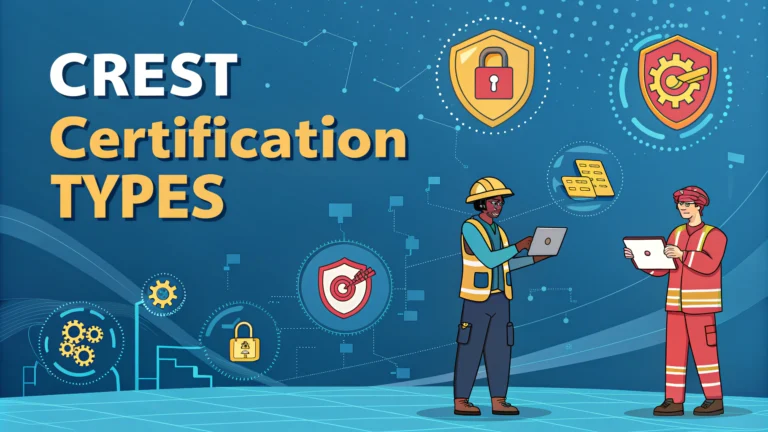CREST certification represents the gold standard for technical security professionals and companies working in penetration testing and information security.
These certifications validate both theoretical knowledge and hands-on technical skills through rigorous practical examinations.
Understanding the different CREST certification types helps security professionals choose the right path for their career development and ensures organizations can hire qualified professionals for their security needs.
Main CREST Penetration Testing Certifications
- CREST Practitioner Security Analyst (CPSA) – Entry-level certification demonstrating fundamental knowledge
- CREST Registered Tester (CRT) – Professional-level certification for security testers
- CREST Certified Tester (CCT) – Advanced certification with Infrastructure and Web App specializations
- CREST Certified Simulated Attack Manager (CCSAM) – Management-focused certification for red team operations
- CREST Certified Simulated Attack Specialist (CCSAS) – Technical specialist certification for red team operatives
Detailed Breakdown of Certifications
CPSA (Entry Level)
The CPSA exam tests knowledge of information security fundamentals through a multiple-choice written examination.
CRT (Professional Level)
CRT certification requires passing both written and practical examinations testing real-world penetration testing skills.
CCT (Advanced Level)
- CCT Infrastructure: Advanced network infrastructure testing capabilities
- CCT Web Applications: Specialized web application security testing skills
- Requirements: Must hold CRT certification first
Red Team Specific Certifications
| Certification | Focus Area | Prerequisites |
|---|---|---|
| CCSAM | Red Team Management | CCT Infrastructure or equivalent |
| CCSAS | Technical Red Team Operations | CCT Infrastructure or equivalent |
Certification Process
- Register with CREST (www.crest-approved.org)
- Select appropriate certification level
- Book examination date
- Complete required examinations
- Maintain certification through CPD points
Exam Preparation Resources
- Official CREST Exam Syllabi
- Practice Papers (available through CREST website)
- Hands-on Lab Environments
- Professional Training Courses
Career Advancement Path
The recommended progression path starts with CPSA, moves through CRT, and then specializes with CCT certifications.
Next Steps for Certification Success
- Contact CREST directly for current exam schedules and requirements
- Join professional networks for exam preparation support
- Practice with virtual labs and testing environments
- Review success stories from certified professionals
For more information and registration details, visit the official CREST website or contact their examination board at [email protected].
Certification Maintenance Requirements
CREST certifications require ongoing professional development to maintain validity and ensure practitioners stay current with evolving security threats.
- Annual CPD points requirement
- Documentation of relevant security activities
- Participation in recognized industry events
- Contribution to security research or publications
Industry Recognition and Benefits
For Professionals
- Enhanced career opportunities
- Industry-recognized expertise validation
- Higher earning potential
- Access to exclusive professional networks
For Organizations
- Quality assurance in security testing
- Compliance with industry standards
- Risk mitigation through verified expertise
- Competitive advantage in security services
Building Your Security Testing Career
CREST certification represents a significant investment in professional development and career advancement within the information security industry. Success requires dedication to continuous learning, practical experience, and commitment to ethical security testing practices.
- Develop a structured learning plan
- Build practical experience through lab environments
- Network with certified professionals
- Stay updated with evolving security trends
- Maintain professional ethics and standards
Securing Your Future in Cybersecurity
CREST certification establishes a strong foundation for long-term success in technical security roles. By following the certification pathway and maintaining professional development, security practitioners can build rewarding careers while contributing to organizational and industry security objectives.
Remember to regularly check the CREST website for updates to certification requirements and new opportunities in the evolving security landscape.
FAQs
- What are the main CREST certification types available for penetration testers?
The main CREST certifications include Practitioner Security Analyst (CPSA), Registered Tester (CRT), Certified Tester (CCT), and Certified Simulated Attack Specialist (CCSAS). - What is the entry-level CREST certification for penetration testers?
The Practitioner Security Analyst (CPSA) is the entry-level certification, testing fundamental technical security knowledge. - What are the different infrastructure certifications offered by CREST?
CREST offers Infrastructure Certifications at three levels: Practitioner (CPSA), Registered (CRT), and Certified (CCT Infrastructure). - What are the web application testing certifications available through CREST?
CREST provides Web Application Certifications at three levels: Practitioner (CPSA), Registered (CRT), and Certified (CCT Web Applications). - What is the validity period of CREST certifications?
CREST certifications are typically valid for three years, after which renewal is required through examination or continuous professional development. - What is the CREST CSAM certification?
CREST Certified Simulated Attack Manager (CSAM) is designed for professionals managing simulated attack engagements and red team operations. - What prerequisites are required for the CCT certification?
Candidates must hold the CRT certification and have a minimum of 2,500 hours of relevant and current experience before attempting the CCT examination. - How does the CREST Registered Tester (CRT) examination differ from CPSA?
CRT is a more advanced, practical examination requiring hands-on testing skills, while CPSA is theory-based and tests fundamental knowledge through multiple-choice questions. - What is the CREST CCSAS certification?
The CREST Certified Simulated Attack Specialist (CCSAS) is an advanced certification focusing on red teaming and simulated attack capabilities. - What are the wireless testing certifications offered by CREST?
CREST offers Wireless Specialist certifications at the Practitioner and Registered levels, focusing on wireless network security testing.







